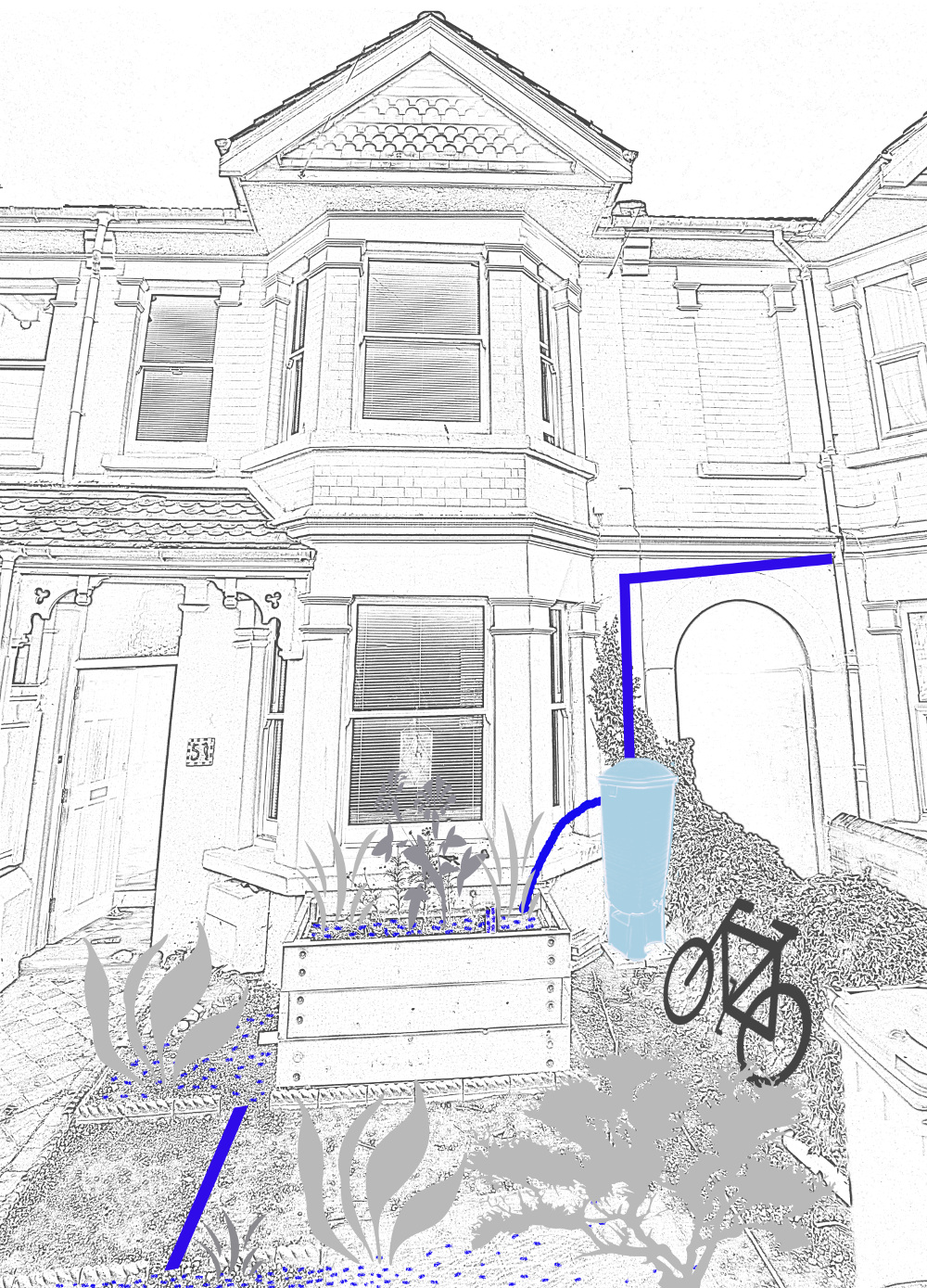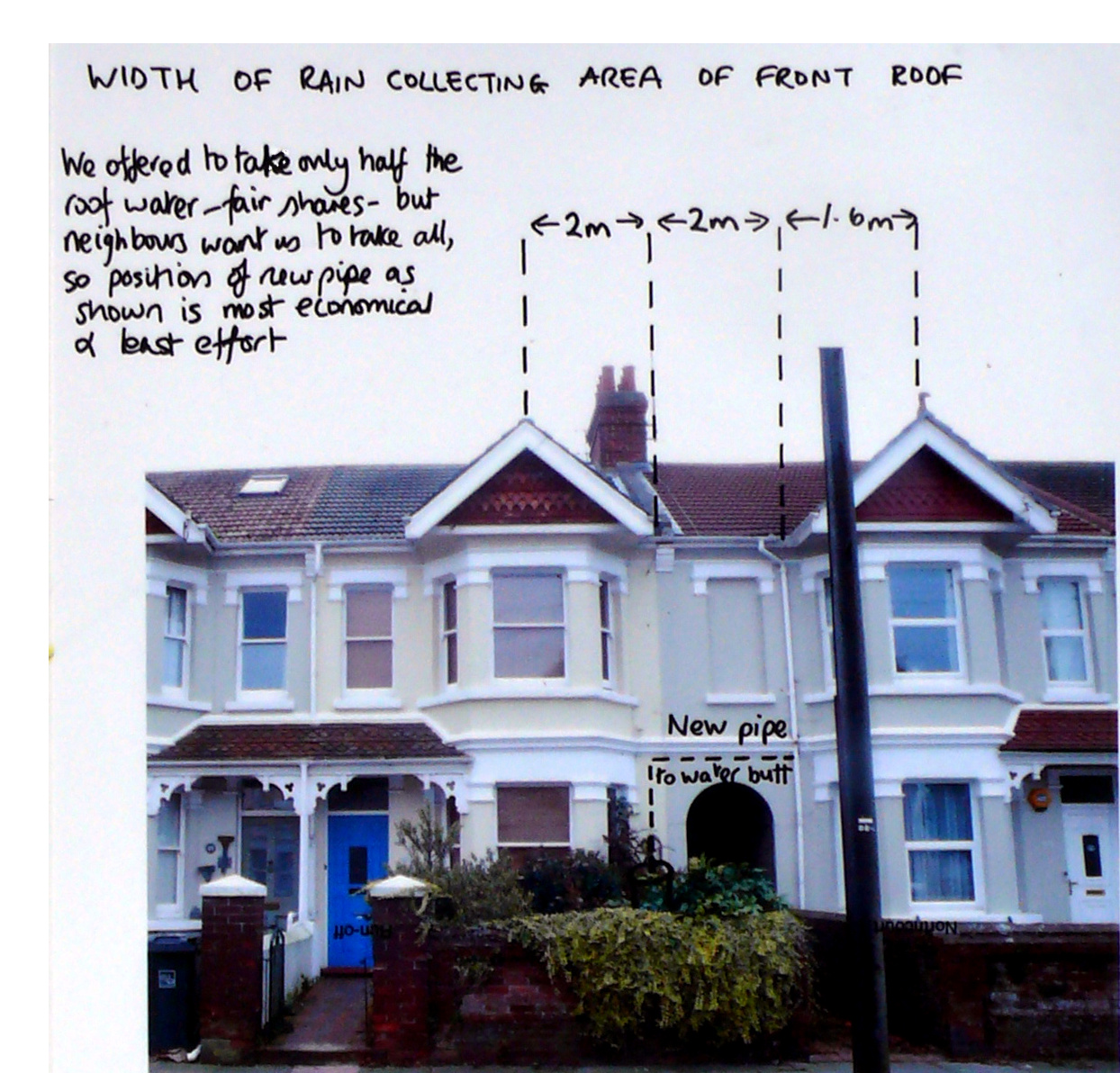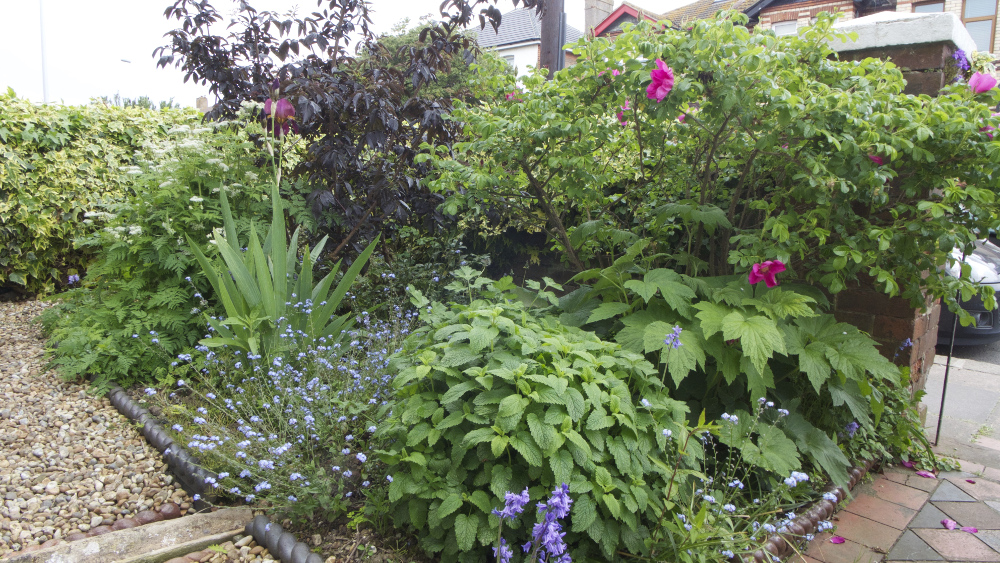By Claire Hunt and Ryan Haines
We live in a street of Victorian terraced houses in Worthing, where the modern curse of paving-over front gardens for off-road parking means that very little rainwater is getting the chance to soak into the ground. In addition, the down-pipes at the front of every alternate house gush straight out into the road. At times of heavy rain this is quite a torrent.
As part of Claire’s Diploma in 2011 we decided to build a rain garden, thereby applying the first permaculture principle of Observe and interact. The concept of a rain garden is to create a rain chain with as many opportunities as possible to catch, store and use rainwater, preventing it from becoming ‘run-off’.

A domestic rain garden potentially embodies every permaculture principle:
-
 Observe and interact – from seeing the problem of rain pouring into the road to interacting and designing this solution.
Observe and interact – from seeing the problem of rain pouring into the road to interacting and designing this solution.
-
Use and value renewable resources – every stage of the rain chain is an opportunity to put the captured water to use.
-
Produce no waste – no run-off.
-
Integrate functions and elements so that a system has several functions and more than one element supporting each function - The rain chain in our small garden has four elements, all capturing water but some also performing other functions. Other elements like the bike shelter sedum roof and gravel paths support these functions too.
- Catch and store resources passing through the system – rainwater.
-
Obtain a yield – from the planting, useful or edible to humans or wildlife, and beautiful and stimulating to the senses.
-
Use and value diversity – through creating different habitats and plant diversity.
-
Use edges and value the marginal – especially in larger systems that include ponds, but in any case because spaces which can be alternately very wet or very dry are marginal for other uses.
-
Creatively use and respond to change – For example, West Sussex Flood Risk Management Strategy says, “Surface water contributes significantly to the flood risk in Worthing due the urban nature of the area”. With the increasing incidence of sudden heavy rainfall due to climate change, rain gardens can help mitigate flood risk, as they do in many other parts of the world with extreme weather.
-
Apply self-regulation and accept feedback – taking action about things within your own control to address an observed problem.
-
Design from patterns to details – observing the pattern of drainage into, on and from the site to determine the placement of elements.
-
Small and slow solutions – an individual household taking responsibility for making a small contribution to reducing run-off and flood risk.
Rain chains - from water butt to planter and elsewhere
 The first element of most rain chains is a water butt, storing water for use in the garden during low rainfall and overflowing when full into the next element.
The first element of most rain chains is a water butt, storing water for use in the garden during low rainfall and overflowing when full into the next element.
Our neighbour was happy for us to divert their downpipe to our water butt, so we collect rain from half of our roof and half of theirs (see photo with annotation). This determined the placement of the water butt. We offered to take only half the roof water - fair shares. The neighbours want us to take all though, so the position of new pipe as shown is the most economical and least effort.
The water butt overflows into a storm-water planter, the second element in the chain. This captures and stores water in the soil, and has a perforated drainage pipe running the length of the planter that exits at the bottom and allows excess water to leave once the soil is saturated. There are drainage and filtration layers of gravel and sand, with the main volume being a mix of top soil, garden compost and sand.
The planter is placed close to the water butt to minimise piping needed. Since only certain parts of our north-facing garden get sunshine in the morning and late afternoon, it is in one of these areas.
 and claire_web.jpg) The internal drainage pipe emerges from the opposite side of the box from the water butt input. A rill made from old roof tiles takes the outflow into a ground-level planted area of the garden, the final element of the chain. This is where most sunshine falls and close to the path where it is most visible.
The internal drainage pipe emerges from the opposite side of the box from the water butt input. A rill made from old roof tiles takes the outflow into a ground-level planted area of the garden, the final element of the chain. This is where most sunshine falls and close to the path where it is most visible.
All the planting has been chosen to tolerate wet and dry periods as well as partial shade and is perennial.
We tweaked the design after observing that water was running off the main bed on to the path after a particularly heavy downpour. We dug in a soak-away to direct the rill outflow towards the elder shrub. Since then there has been no run-off to the street, whatever the weather, and the garden is self-sustaining, lush and blooming.
Eco open houses
The house and garden are often open during Transition Town Worthing’s Eco Open Houses weekends. Local people learn how to create their own rain garden and go away feeling inspired. Hopefully, this article has inspired you too - see the resources below for more information on creating your own rain garden.

Resources
Worthing Open eco homes case study
Building a planterbox rain garden (opens a pdf)
Wildfowl and Wetland Trust leaflets on rain gardening